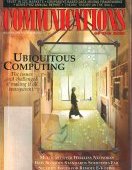December 2002 - Vol. 45 No. 12

Features
Cyberspace Across Sub-Saharan Africa
Teaching Reviewing to Graduate Students
Multicast Over Wireless Networks
Security Considerations For Remote Electronic Voting
The Value of Seller Trustworthiness in C2c Online Markets
Emergent Patterns of Integration in Electronic Channel Systems
Strategic It Applications in Health Care
Anytime/anyplace Computing and the Future of Knowledge Work
Group Dynamics and Ubiquitous Computing
New Frontiers of Application Design
The Future of Business Services in the Age of Ubiquitous Computing
The Relevance of Social Issues in Ubiquitous Computing Environments
Software Infrastructure and Design Challenges For Ubiquitous Computing Applications
Striving to integrate computing into everyday activities in a seamless manner.
Why Security Standards Sometimes Fail



